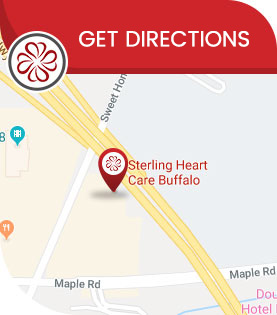The History of ECP Therapy
Here are some facts about the history of ECP therapy. ECP therapy has been around since the 1960s and is still a very effective medical practice today. Dr. Leon Levinsky, MD, and his team offer non-invasive ECP therapy at Sterling Heart Care. For more information, contact us or schedule an appointment online. Visit our clinic at 4330 Maple Rd. Buffalo, NY 14226, to find out more about how ECP therapy can help you take charge of your heart health.


It is important to understand the The History of ECP Therapy and how it may benefit you. ECP Therapy, short for External Counter Pulsation Therapy, is not a new fad in medicine. It has been around for decades. This proven heart therapy method has been refined over the years, and new applications have been found for it. We are proud to offer this alternative heart treatment at Sterling Heart Care.
The History of External Counter Pulsation & Sterling Heart Care
1960’s
Dr. Clifford Birtwell first began to explore the effects of increasing blood flow during the diastolic phase of the heartbeat. The theories behind ECP therapy are based on his work. At first, Dr. Birtwell experimented with removing the blood directly from the femoral artery during systole and then injecting it back into the body during diastole. His studies and experiments show that the stress on the arterial walls was reduced and the blood flow back to the heart was increased.
Late 1960’s
With that research, the IABP was invented. Short for Intra-Aortic Balloon Pump, a balloon device was placed into a patient’s aorta via a catheter. When set, it would inflate during the diastole and deflate during systole. The results were the same physiological effects as physically withdrawing the blood and injecting it back, as done by Dr. Birtwell.
While ECP therapy eventually replaced this device to improve circulation, IABP proved to be tremendously successful and is still used today during surgeries. ECP replaced it because of the invasive nature of the procedure and the complications that came along with it.
1968
The first External Counter Pulsation device was created to treat patients for heart attack, ischemia, cardiogenic shock, and other conditions. The first version of this equipment was much larger than the equipment we used today. This large device used water instead of air to operate the external cuffs.
1970’s
ECP machines continued to be refined and become more advanced. Benefits of ECP therapy continued to be shown for patients with acute myocardial infarction, stable angina, and cardiogenic shock. Widespread adoption of ECP therapy did not take hold in the United States with the invention of Coronary Artery Bypass Graft Surgery. However, ECP Therapy became standard in countries across the world, especially in the eastern hemisphere.
1970
Research was conducted at Sun Yat Sen University in China where scientists found that ECP Therapy provides long lasting and beneficial relief to symptoms related to heart disease in nearly 90% of patients. These patients, who suffered from heart attacks and angina, showed incredible recovery when they underwent this therapy. These results encourage Dr. Harry Soroff at the Health Science Center at Stony Brook University to explore and research ECP therapies in the United States.
1972
The FDA approved ECP Therapy to treat heart attacks and cardiogenic shock. Increased research and interest continued to grow.
1990’s
FDA approval of ECP Therapy spurs new interest and research into it for heart treatment therapy. Many clinical studies and research papers establish enormous benefits from this therapy for patients battling heart and other cardiovascular diseases.
1995
The FDA approves ECP Therapy to treat Angina Pectoris. This condition is associated with the painful symptoms of coronary artery disease. Symptoms often include shortness of breath, fatigue, and chest pain.
2000
The Center for Medicare Services approves ECP Therapy to treat symptoms related to Coronary Artery Disease. These symptoms include:
- Angina – Chest Pain
- Dyspnea – Shortness of Breath
- Related fatigue
Major insurances begin to approve ECP Therapy to treat these conditions also.
2015
Sterling Heart Care received additional approval from the FDA to use ECP devices to treat healthy patients. ECP Therapy is used to improve VO2, enhance vasodilation, and increase blood circulation.
2017
To bring External Counter Pulsation Therapy to a broader community in Western New York, Sterling HC Management is founded. The first Sterling Heart Care Site is opened.
2018
Along with Medical ECP of Western New York, Sterling HC Management opens the first Sterling Heart Care site in Buffalo, New York located at 4330 Maple Rd. in Buffalo, NY 14226.

Additional Services You May Be Interested In
▸ECP For Heart Disease
▸ECP Therapy For Circulation
▸ECP Therapy For Athletes
▸History of ECP
▸ECP Therapy
▸Cardiac Rehabilitation Services
▸ECP Treatment Center Near Me
▸Cardiovascular Disease Treatment in Buffalo, NY
▸Heart Disease Treatment in Buffalo, NY
▸ECP Therapy Near Me Cheektowaga, NY
▸Cardiac Rehab Program
▸Stress Management Specialist

Additional Services You May Be Interested In
▸ECP For Heart Disease
▸ECP Therapy For Circulation
▸ECP Therapy For Athletes
▸History of ECP
▸ECP Therapy
▸Cardiac Rehabilitation Services
▸ECP Treatment Center Near Me
▸Cardiovascular Disease Treatment in Buffalo, NY
▸Heart Disease Treatment in Buffalo, NY
▸ECP Therapy Near Me Cheektowaga, NY
▸Cardiac Rehab Program
▸Stress Management Specialist


